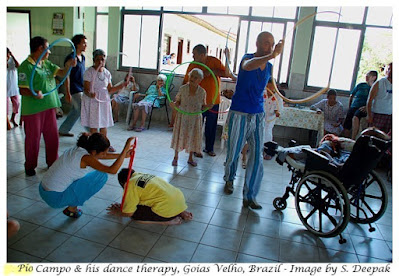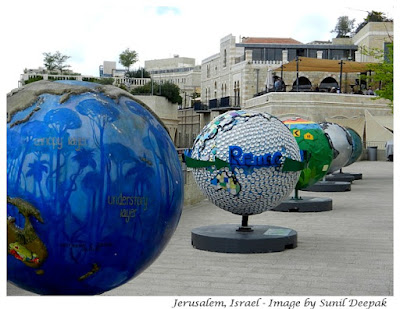In July 2019, the "Global Disability Action Plan (GDAP) 2014-2021" of the World Health Organisation (WHO) was replaced by the "Rehab 2030" plan. This post is about the key differences between GDAP and Rehab 2030 and also about my opinions regarding the new plan. (Click on the images for a bigger view)
Global Disability Action Plan (GDAP) 2014-21
The overall goal of the GDAP 2014-21 was "Better health for all persons with disabilities" and it had three objectives:(1) To remove barriers and improve access to health services and programmes
(2) To strengthen and extend rehabilitation, habilitation, assistive technology, assistance and support services and community-based rehabilitation (CBR)
(3) To strengthen collection of relevant and internationally comparable data on disability and support research on disability and related services
The GDAP 2014-21 was supposed to reach these 3 objectives through human rights based approach, empowerment of persons with disabilities, life-course approach, culturally appropriate person-centred approach, multi-sectoral Community-Based Rehabilitation (CBR) and universal design.
Rehab 2030 Plan
The new plan has a wider view of the rehabilitation services by focusing on functionings which can be limited due to health conditions, environment and by the interaction between these two. It proposes to develop Packages of Rehabilitation Interventions (PRIs) for the following groups of functionings within the next 10 years:(1) Musculo-skeletal: Low-back pain, neck-pain, fractures, other injuries, Osteoarthritis, amputation, rheumatoid arthritis
(2) Neurological: Cerebral palsy, brain injury, Alzheimer-dementia, spinal cord injury, Parkinson's disease, Multiple sclerosis, motor neurone disease, Guillain-Barré syndrome
(3) Cardio-Vascular Diseases including myocardial infarction and heart failure
(4) Chronic respiratory diseases
(5) Neoplasms & tumours
(6) Mental health conditions: Schizophrenia, Developmental and intellectual disabilities, Autism spectrum disorders
(7) Sensory Impairments: Hearing loss, Vision loss
Rehab 2030 aims to make these PRIs to be available as part of the Universal Health Coverage at different levels of the health services, as shown in the graphic below.
Changes from GDAP to Rehab 2030
From Impairments to health conditions: In many ways, the vision of Rehab 2030 is very different from that of GDAP. Till GDAP, the focus was on the effect of impairments. The focus of Rehab 2030 is on the impact of health conditions. This subtle shift, focusing on "health conditions" instead of "impairments caused by the health conditions" opens rehabilitation programmes to the needs of other groups of persons, such as elderly persons, and persons with cardiac and respiratory conditions.Rehabilitation Interventions: The other significant change from the past is the focus on "rehabilitation interventions". During the late 1980s and early 1990s, the Disability & Rehabilitation team at WHO had decided to focus on the delivery of rehabilitation services at community and primary health care level, leaving aside the issues related to rehabilitation interventions at intermediate and higher levels. However, over the past 20 years, new technologies have introduced a better understanding of health conditions and raised opportunities for their treatment which were not available in the past. WHO needs to provide guidance about these interventions. For example, today some children born with deafness can have cochlear implants and grow up hearing. This change goes in that direction.
Outreach Services: Another significant change is the acknowledgement of a level of rehabilitation services, which was not mentioned in any WHO document over the past many years, the "community-delivered rehabilitation". During our visits to rehabilitation services in different countries, we often came across the rehabilitation staff visiting some peripheral or rural areas to provide rehabilitation in the communities. This was called "outreach rehabilitation services". I remember a few discussions in WHO about the undesirability of these outreach services - they were costly, and often did not have adequate staff. I think that by acknowledging the Outreach services, it accepts an existing reality instead of closing our eyes to it due to ideological beliefs.
Needs for defining community rehab interventions: I also hope that through the PRIs, Rehab 2030 will also look at defining of rehabilitation interventions for "informal and self-driven rehabilitation". During 1990s, WHO had played a crucial role in development of simple manuals on basic rehabilitation interventions, for example, for children with cerebral palsy and persons with spinal cord injury. Today, many countries have CBR as part of their national rehabilitation strategies. It will be useful for them to have updated information on evidence-based basic rehabilitation interventions for use at self-care and community level (though in part, internet is bringing better information, skills and technological support to the communities and families, who can also share their personal experiences with other communities).
Social Model and Rehab 2030
Rehab 2030 hardly ever uses the word "persons with disabilities", because it focuses on "functioning related to health conditions" instead of "impairments". However, persons with disabilities will be one of the biggest group of the users of the rehabilitation interventions and it will be difficult for WHO to not engage with them. The UN Convention on the Rights of Persons with Disabilities (CRPD) and the focus of Sustainable Development Goals on persons with disabilities, make it obligatory for WHO to engage with the Organisations of Persons with Disabilities (DPOs/OPDs). For example, the UN Flagship report on disability which came out earlier this year (2019), it also links with rehabilitation and assistive technology services.During 1980s-90s, the Disabled Peoples' Organisations (DPOs or Organisations of Persons with Disabilities OPDs) came up with the "social model of disability", which was seen in contra-position to the "medical model of disability", implying that medical rehabilitation services were somehow bad or not useful. I personally believe that the two models are complementary - medical model focuses on individuals with impairments and social model, helps us to fight against the barriers created by the society. Both are needed. Rehabilitation interventions in the health services can not be organised through the social model - they are medical interventions and are carried out in line with the way medical/health services are organised.
Persons with stable impairments such as persons who are blind or deaf or those who had a disability in the childhood and are now grown-up, such as persons with cerebral palsy, often complain about "labelling" of their identities with their clinical diagnosis, which creates specific expectations and prejudices among people. However, rehabilitation services cannot provide treatment without a diagnosis. Such issues will continue to be a cause of friction between persons battling for superiority of social model over the medical model of disability. However, persons with disabling progressive health conditions understand the complementarity of the two models of disability in their lives much better.
Final Comments
The famous Alma Ata conference on primary health care (PHC) held in 1977 had proposed "preventive, promotive, curative and rehabilitative care" at the community level. However, in practice, citing lack of resources, PHC was limited to certain key interventions, which had excluded rehabilitation services.During the 1990s, repeated attempts to promote inclusion of rehabilitation services in PHC had yielded little or no results. Only during the past 10-15 years, some countries have adopted the CBR approach and a few of them have linked it with their PHC services.
Today, in most countries we have persons with disabilities and DPOs/OPDs who are strong advocates for their rights while countries have signed and ratified CRPD. New national disability policies and programmes related to SDGs may also be offering opportunities for promoting rehab services in countries, which were not there in the past.


















































